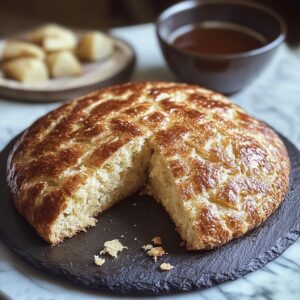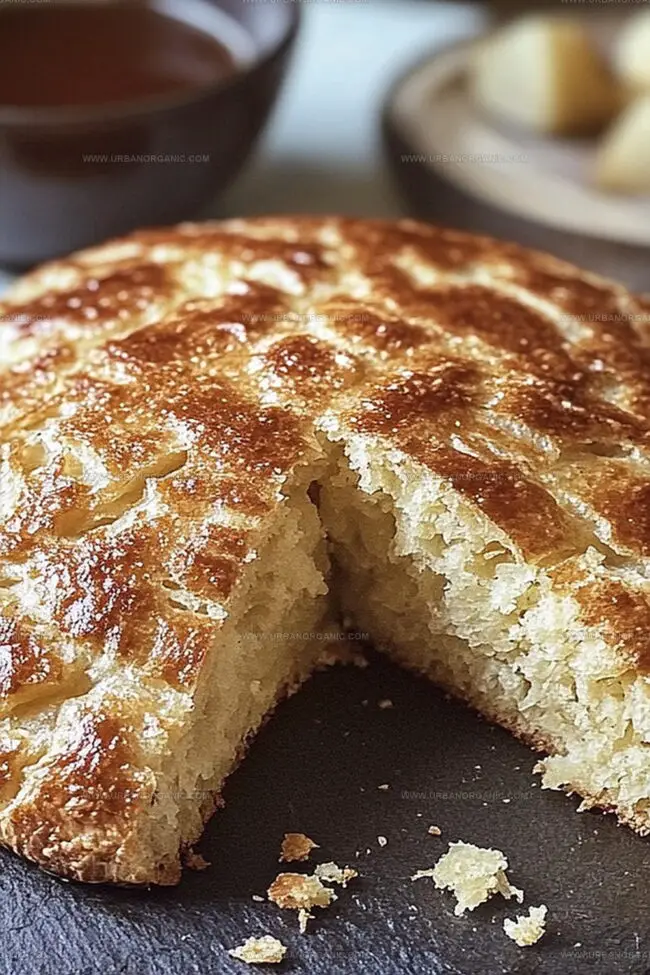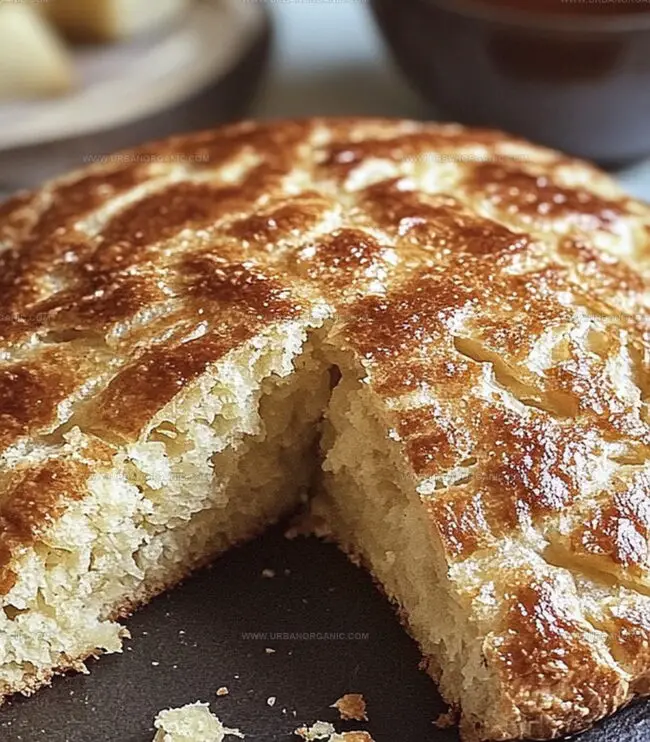Irish Potato Bread Recipe for Homemade Comfort
Crispy golden potato flatbreads have been a delightful staple in irish potato bread traditions for generations.
Hearty farmers and home cooks crafted these simple yet satisfying rounds using basic pantry ingredients.
Potatoes bring exceptional moisture and a subtle earthy richness to this classic bread.
Russet or white potatoes work beautifully, creating a tender interior with a slightly crusty exterior.
Kneading becomes a meditative process when you connect with centuries of culinary heritage.
Salt and flour blend seamlessly, creating a canvas for countless meal possibilities.
Let this recipe inspire you to transform humble ingredients into something truly magical.
What Makes Irish Potato Bread a Savory Favorite
What Goes into Authentic Irish Potato Bread
Main Ingredients:
Potato Base:Dry Ingredients:Cooking Components:Baking Instructions for Soft and Hearty Bread
Step 1: Prepare Potato Base
Peel whole potatoes and place them in a pot of cold water. Boil until tender and easily pierced with a fork. Drain water completely and mash potatoes until smooth and creamy, eliminating all lumps. Allow potatoes to cool slightly to room temperature.
Step 2: Create Soft Dough
In a spacious mixing bowl, combine:Blend ingredients thoroughly using a wooden spoon or hands until a soft, slightly sticky dough forms. The texture should hold together without crumbling.
Step 3: Shape Delectable Farls
Sprinkle a clean countertop with a light dusting of flour. Transfer dough onto surface and gently roll out to approximately half-inch thickness. Use a sharp knife to divide dough into four equal triangular sections, creating traditional potato farls.
Step 4: Griddle Cooking Magic
Warm a non-stick skillet or cast-iron griddle over medium heat. Carefully place potato farls onto hot surface. Cook each side for 3-4 minutes until edges turn golden brown and surfaces develop a delicate crispy exterior. Watch carefully to prevent burning.
Step 5: Serve and Enjoy
Transfer cooked potato bread to a serving plate. Slice and serve warm alongside butter, jam, or as a hearty breakfast accompaniment. Best enjoyed immediately after cooking.
Tips for Better Texture and Crust
Save and Reheat Potato Bread the Right Way
What to Pair with Irish Potato Bread
Variations on Potato Bread Worth Trying
FAQs for Irish Bread Enthusiasts
Yes, mashed potatoes are the key ingredient that gives this bread its unique texture and flavor, creating a soft and slightly dense bread with a rich, comforting taste.
Absolutely! Leftover mashed potatoes work perfectly and are a great way to reduce food waste while creating a delicious bread.
No, Irish potato bread is quite different from regular bread. It’s flatter, more dense, and has a unique texture due to the potato content, making it more like a hearty flatbread or griddle bread.
Not at all! This recipe is beginner-friendly and requires basic mixing and cooking skills. Even novice home cooks can successfully make delicious potato bread with simple ingredients and techniques.
Print
Irish Potato Bread Recipe
- Total Time: 25 minutes
- Yield: 4 1x
Description
Savory Irish potato bread brings rustic comfort straight from Ireland’s hearty kitchens. Warm, golden slices melt with rich butter, inviting you to savor traditional countryside flavors in each delightful bite.
Ingredients
Main Ingredients:
- 2 cups (473 ml) mashed potatoes
- 1 cup (125 g) all-purpose flour
Seasoning and Leavening:
- ½ teaspoon salt
- ¼ teaspoon baking powder
Additional Ingredients:
- 2 tablespoons (30 ml) unsalted butter, melted
Instructions
- Transform boiled potatoes into a smooth, lump-free mash by thoroughly crushing them with a potato masher or fork, allowing the mixture to cool to a warm temperature.
- Combine the mashed potatoes with flour, creating a soft, pliable dough that incorporates melted butter, salt, and baking powder until fully integrated.
- Dust a clean work surface with a light layer of flour to prevent sticking, then gently knead the potato dough briefly to ensure even consistency.
- Roll out the dough with a rolling pin to achieve a uniform 1/2-inch thickness, creating a smooth, even surface.
- Slice the flattened dough into four equal triangular sections, ensuring clean, precise cuts that create traditional potato bread farls.
- Preheat a non-stick skillet or heavy griddle to medium heat, allowing the surface to warm evenly without becoming too hot.
- Carefully transfer the potato bread triangles to the heated surface, cooking each side for 3-4 minutes until a rich golden-brown color develops and a crisp exterior forms.
- Remove the potato farls from the skillet, letting them rest momentarily on a wire rack or clean kitchen towel to prevent soggy bottoms and maintain their delightful texture.
Notes
- Choose waxy potatoes like Yukon Gold for the best texture and flavor in your potato bread.
- Allow mashed potatoes to cool slightly before mixing to prevent overworking the gluten in the flour, which can make the bread tough.
- Adjust flour quantity based on potato moisture – wetter potatoes might require a bit more flour to achieve the right dough consistency.
- For a gluten-free version, substitute regular flour with a blend of gluten-free flour and add xanthan gum to help bind the ingredients.
- Keep the dough thickness consistent when rolling out to ensure even cooking and a uniform texture across all farls.
- Consider adding herbs like rosemary or thyme to the dough for an extra flavor dimension that complements the potato’s natural richness.
- Use a cast-iron skillet for more even heat distribution and a crispier exterior when cooking the potato bread.
- Store leftover potato bread wrapped in a clean kitchen towel to maintain moisture and prevent it from drying out too quickly.
- Prep Time: 10 minutes
- Cook Time: 15 minutes
- Category: Breakfast, Snacks
- Method: Frying
- Cuisine: Irish
Nutrition
- Serving Size: 4
- Calories: 220
- Sugar: 2 g
- Sodium: 600 mg
- Fat: 8 g
- Saturated Fat: 1 g
- Unsaturated Fat: 7 g
- Trans Fat: 0 g
- Carbohydrates: 24 g
- Fiber: 4 g
- Protein: 18 g
- Cholesterol: 60 mg




Jessica Martinez
Pastry Chef & Recipe Developer
Expertise
Organic Baking Techniques, Gluten-Free Recipe Development, Southwestern Dessert Specialties, Food Styling and Photography
Education
Santa Fe Community College (SFCC)
Jessica brings the sweet side to Urban Organic with her passion for baking and love for the Southwest. She trained at Santa Fe Community College and has built a career creating beautiful, gluten-free, and organic desserts that feel both nostalgic and new.
She believes baking should be fun, creative, and open to everyone, no matter your diet or skill level. Jessica’s recipes are simple enough to follow, but special enough to remember.